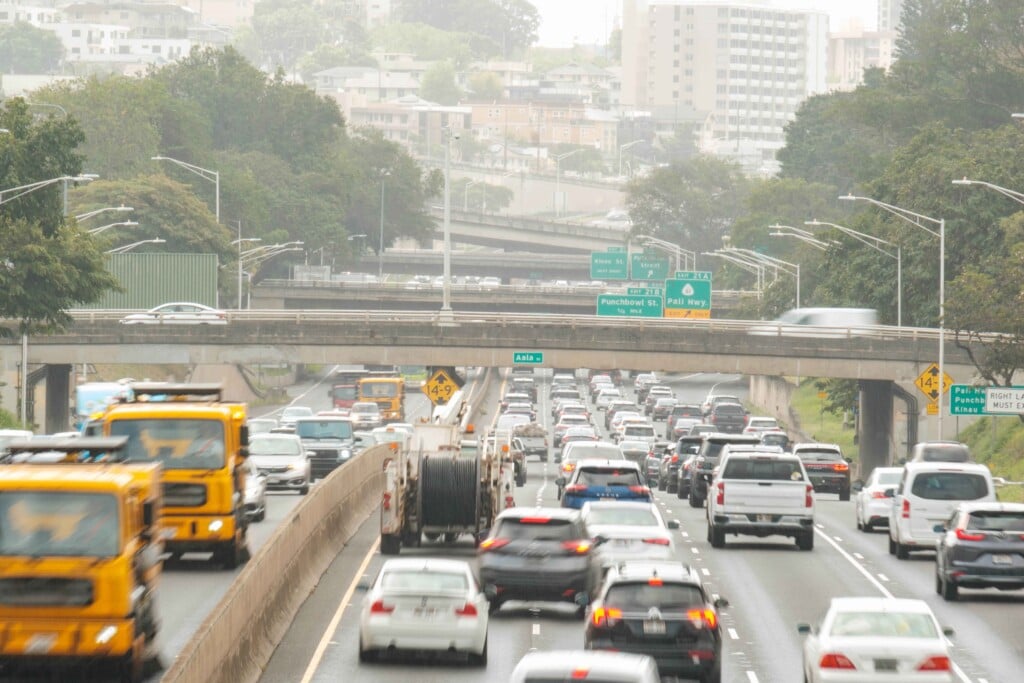EV Sales in Hawai‘i Are Up 30.6%, and Many Buyers Say They’re Glad They Made the Switch
An electric car (or bike!) is cheaper per mile than gas-powered vehicles and far better for the environment.

David Aquino traded his Tacoma pickup truck for a Kia Niro EV last year as part of his New Year’s resolution to contribute to a cleaner future. Daniel Mayberry is saving for an electric car, but in the meantime bought an electric bike for his 10-mile daily commute each way to and from work.
“Being born and raised in Hawai‘i, I spent a lot of my time in and around the ocean so I could see the impacts we were having on our oceans and reefs,” says Aquino, creative director at Blue Planet Foundation, a local nonprofit that advocates for clean energy. “It got me thinking about what I could do personally to contribute to a cleaner future and solve the problem of climate change.”
Emissions from gas-powered cars contribute significantly to atmospheric carbon dioxide and to climate change. Electric vehicles can help reduce that problem.
Kianiwai Jones, clean mobility director at Blue Planet Foundation, is another advocate of EVs. “They’re better for the environment,” she says. “There’s no tailpipes so there are no tailpipe emissions. That means cleaner air and better public health benefits.”
Many EVs are powered by electricity from the grid, and the grid itself is still largely powered by fossil fuels, but EVs are three or four times more efficient at converting that same fossil-fuel energy to power than gas cars, according to the federal Department of Transportation. And every year, the Hawai‘i grid’s power gets cleaner.
“We are progressing toward 100% clean energy in 2045,” says Jones. “According to Hawaiian Electric, in 2020 we had about 35% of electricity generated from renewable energy sources. Every year it progresses, EVs are becoming cleaner” because the electricity they run on is getting cleaner.
There are also financial benefits to driving an EV. Though sales prices are generally higher than equivalent gas-powered vehicles, fuel is cheaper and EVs require less maintenance. “EVs initially have a higher vehicle price but it’s mitigated by the fact that there are incentives,” says Jones. “The federal tax credit is from $2,500 to $7,500 for an EV.”
Aquino is leasing his EV for $300 a month; Mayberry paid $1,512 for his electric bicycle.
“There are no tailpipe emissions. That means cleaner air and better public health benefits.”
– Kianiwai Jones, Clean Mobility Director, Blue Planet Foundation
“I found that I spent 40% less on my EV than I did on my pickup truck,” Aquino says. “It’s things like not having to spend $60 when I go to the gas station and not having to change out oil and do maintenance that I’d have to do with a gas car.”
Electricity as a fuel is less expensive than gas, Jones says. “Even in Hawai‘i where electricity rates are the highest in the nation, if you compare an EV to a gas vehicle, EVs are cheaper on a dollar per mile basis. EV owners can also save hundreds of dollars in annual fuel costs.”
Mayberry looked for an electric bicycle when he returned to the office a year and a half after the coronavirus pandemic began. “I spent a year doing research to see what was out there,” says Mayberry, a public affairs specialist for the Navy. “I had two requirements for an electric bike: one that it had a range of 20 miles, and two that I could keep it in my apartment.”
After test driving a few bicycles, he purchased a Qualisports Dolphin folding electric bicycle. Mayberry says his work commute is more efficient now. “It takes me the same amount of time to bike to work as it does to drive to work,” he says. “I’m able to get about 10 miles in 40 minutes versus when I was riding my regular bike it took me 40 minutes to go 5 miles.” Mayberry’s wife also uses the bicycle.
Related stories: Here’s How Hawaiʻi Plans to Expand its Electric Vehicle Charging Infrastructure, Amply Makes it Easier for Fleets to Convert to Electric Vehicles,
Electric Car Range Anxiety
Jones says EV sales prices will go down as more of the cars become available. In the meantime, for people who can’t afford a new EV, she recommends looking at used ones.
Another consideration is charging and infrastructure. “Not everyone has access to charging at home so we need to improve the availability of commercial charging infrastructure,” says Jones. “Blue Planet Foundation continuously works toward advancing policy that helps to increase availability of commercial charging stations at multi-unit dwellings and public and workplace locations.”
The website Bumper.com ranks Hawai‘i as the 10th best state for EV-friendly policies, charging networks and incentives. Also, it reported that 0.84% of all motor vehicle registrations last year in Hawai‘i were for EVs, the second-highest rate in the nation after California.
In August 2021, the state had 16,216 electric passenger vehicles, an increase of 30.6% from the same month last year, according to the monthly energy trend report from Hawai‘i’s Department of Business, Economic Development & Tourism.
“People are realizing the benefits of owning an electric vehicle,” says Aquino. “I feel as though electric vehicles are the future in Hawai‘i and I’m excited that I’m able to be a part of that future.”






